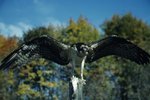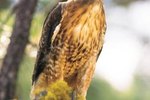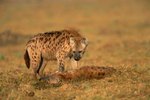Haast's eagles gets their name from Dr. Julius von Haast, who described the species' first discovered bones in 1871. Dr. Haast was the first director of the Canterbury Museum in New Zealand. Haast eagles lived in the southern island of New Zealand.
Description
Haast's eagles flew with 3-meter wingspans and weights between 30 and 40 pounds. They were capable of taking down prey more than 10 times their weight and might have preyed on humans as well as animals. They were the only eagles deemed top-tiered predators.
Prey
The Haast's eagle could scavenge, but it primarily hunted the giant moas, a bird which is now also extinct. Large flightless birds, some moas stood as tall as 2 meters or 6 1/2 feet and weighed more than 550 pounds. Other moas were much smaller, some being the size of a turkey. Ten species of moas were in New Zealand. Another prey animal may have been Finsch's duck, a flightless duck that is also extinct.The Maori have a legend about the Haast's Eagle, which they called Te Hokioi: The story goes that children, and even adult humans, could fall prey to this enormous bird. According to the curator of vertebrate zoology at the Canterbury Museum in New Zealand, Paul Scofield, the Haast's Eagle was certainly capable of killing or carrying off a child.
Hunting Methods
Haast's eagles hunted by perching high in trees and diving on their prey at speeds close to 80 kilometers per hour. These eagles knocked giant moas off their feet, tearing into the giant flightless birds with their talons.
Extinction
Haast's eagles went extinct about 500 to 1,000 years ago, about the same time as their primary food source, the moas, went extinct. The Maori also hunted the Haast's eagles. The moas went extinct shortly after the Polynesian colonization of New Zealand, presumably due to overhunting. It is thought that explorer Charles Douglas may have shot the last known pair of Haast's eagles during an expedition.
Numbers
Haast's eagles were never numerous on the South Island. Experts estimate maybe 1,000 mating pairs. Only three complete skeletons have been found. It's likely that with the few numbers, and the moa's extinction, the Haast's eagle was doomed to extinction as well.





